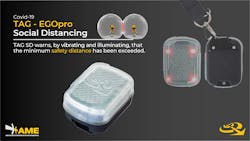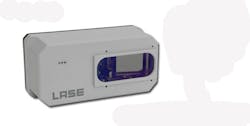Heavy and moving machinery has the potential to cause serious injury or death in the workplace. In 2018, 5,250 workers were killed on the job according to OSHA, and 2.8 million injuries were reported to the US Bureau of Labor Statistics. Power Industrial Vehicle (PIV)s accidents are often the leading cause of workplace injuries and death, making man-to-machine safeguards essential to workplace safety.
In March of this year, the workplace was introduced to a new danger: COVID-19. Over 53% of manufacturers have had a change–or total disruption–of operations reported by the National Association of Manufacturers, and 73% will face financial losses. Hundreds and thousands of workers in factories across the country tested positive for Coronavirus due to a lack of personal protective equipment on the job.
When the biggest workplace safety threat was man-to-machine, RFID technology was used to ensure people stayed a safe distance away from work equipment. A machine mounted sensor sends a regular radio pulse to measure the distance between itself and RFID tags worn by people. When the person wearing the tag is too close to a machine’s receiver, meaning an unsafe distance, their tag vibrates to alert them they have breached a minimum safe distance. In addition, the machine operator is warned of a potentially dangerous situation.
Today, this technology has been upgraded to keep people safe around each other. The CDC recommends individuals uphold a social distance of six feet. In a work environment, these metrics may be difficult or impossible to measure.
Products like Italian company AME’s EGOpro Active Tag have been updated by introducing UWB technology to help maintain safe distances between people instead of machines. Now, when social distancing space is violated, the tag vibrates and flashes a red LED. Ideal for factories, warehouses and construction sites, the tags vibrate and flash to take the guesswork out of the safe minimum distance of six feet.
Beyond essential work such as manufacturing facilities, warehouses, and meat packaging plants, other locations can utilize this tech to keep the general public safe. Tags could be embedded into shopping carts at grocery stores for shoppers to remain distant from one another or given to museum patrons with self-guided tour equipment.
When it’s not feasible to give individuals equipment to maintain social distance, there are other technology applications that can measure distance. Before COVID-19, public venues needed a way to measure traffic and building capacity, particularly outdoors. Also called “people counting,” capacity verification uses standalone 3D cameras to measure the number of people in small spaces, and a laser grid system for larger or more open spaces. When the system detects too many people in a given area, it can send an alert to the designated manager on duty to break up any overcrowding.
As nonessential businesses reopen at limited capacities (e.g., 50 to 75% occupancy), people counting technology is the ideal way to ensure occupancy thresholds are maintained and to prevent overcrowding in highly trekked areas. Products like LASE PeCo can tell the difference between adults, children, and inanimate objects like shopping carts or trolleys and will send an alert if too many people have congregated. It can also be integrated with gates, doors or alarms to notify people in the area when there is too much crowding or the area has reached maximum capacity.
While COVID-19 has added yet another new threat to the workplace, the need to keep employees safe and healthy remains a top priority. Social distancing technology, especially those repurposed from existing safety technology, is an easy, cost-effective, and non-invasive way to follow government safety guidelines and ensure employees and managers are able to keep themselves and their coworkers safe.
Advanced Industrial Marketing (AIM) was founded in 1998 to bring unique technology solutions to major industrial companies across North America. With sales offices in Indianapolis, Chicago, Detroit, and Atlanta, AIM’s team of seasoned professionals offers a full range of sales, consulting, procurement, and technical services to a wide range of customers.












